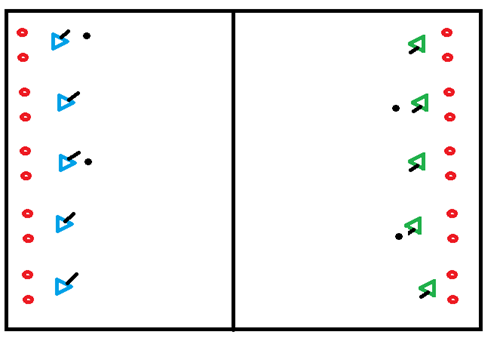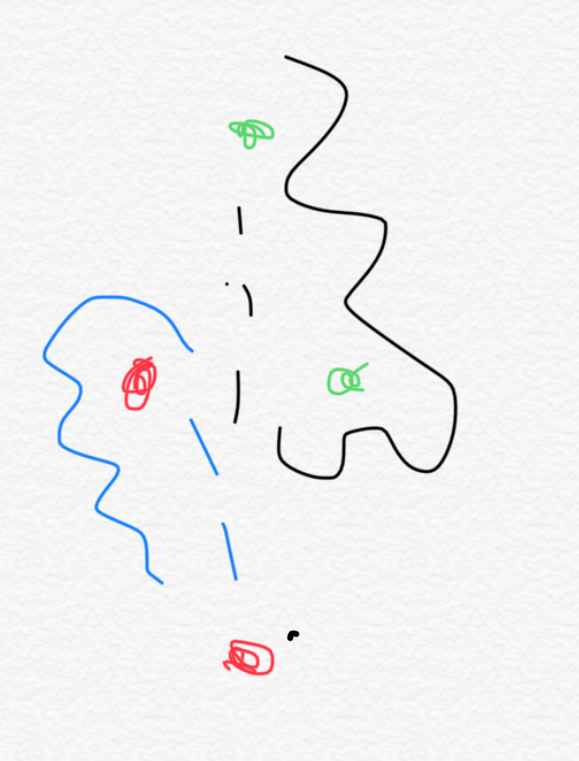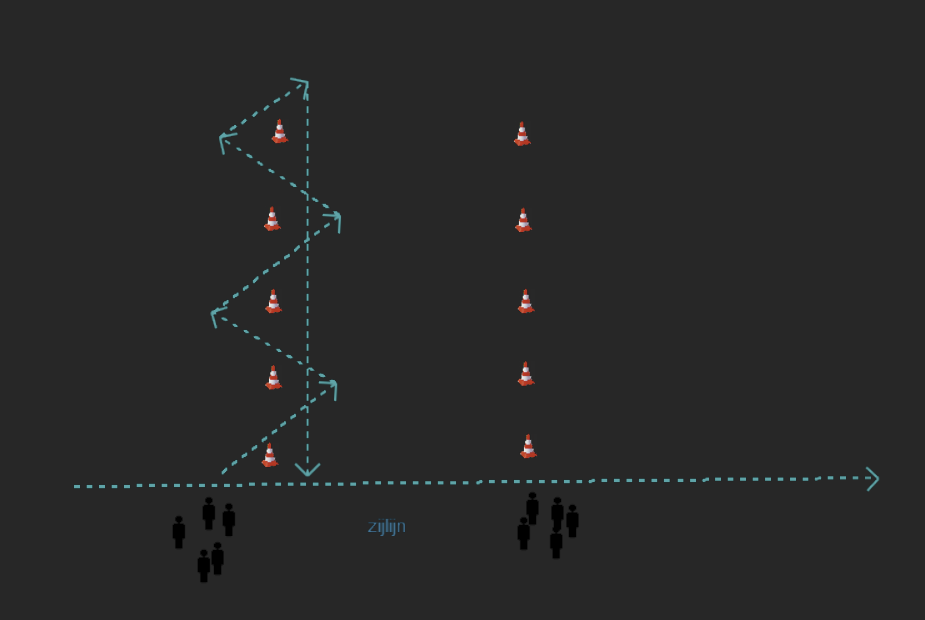Hockey exercises for u8
Couples or with three players.
receiving:
- focus on the grip of there hands, on your left hand you can read your watch.
- push your left hand forward
- Left food in front
passing:
- bend your knee
- left food in line with the ball
- left shoulder in line with left knee
- swing for a hit or slap
- Two teams with substitutes, substitutions are made when a goal is scored.
- Each person defends a goal, on each field there are 5 goals,
- so there are also 5 people who defend these goals.
- If a goal is scored in your goal, you have to sit on the sidelines and you become a substitute.
- A new player (substitute) from the side enters the field and will defend the goal.
- If a goal is scored, it is 1 point.
- The team that has the most points at the end of the game is the winner.


- Someone runs in from the red, takes the ball in the run and runs away strongly,
- he/she plays it to the other person who is standing near red.
- Green comes running in, takes the ball in the run and turns away strongly, playing to the other person who is standing near green.
- 2 pawns face each other,
- at a random distance (depends on whether you want to push or flatten, for example).
- Player 1 and 3 stand with pawn A.
- Player 2 stands at pawn B.
- 1 plays the ball to player 2,
- 2 receives the ball.
- After player 1 passes the ball, he runs after his ball towards pion B.
- When player 2 has passed again he runs in the direction of pion A.
- etc. etcde
- You can play this exercise with minimum 3 players, maximum 5 otherwise the intensity will be very low.
Overplaying to score
- Two players continuously play the ball over
- until one of them is so close to the goal
- that he can score in the goal.
Variation 2-1 situation:
- Under pressure from the defender, the attackers must now play together and try to score.
- The defender can score a point by conquering the ball and then dribbling over the dead ball line.
- This is the short side without a goal.
- divide the team by 2 and run it.
- Sit on top and blow the whistle on any fouls called
- so they get used to it.

- A slalom exercise
- watch how the hands are holding the stick
- where they have the ball
- And if they use the stick properly when they run through the exercise!
- If it goes well, you can make a game of it and see if they master this. The team that has been through all the exercises first has won.
- Players divided into two groups on one side of the field.
- Two rows of cones next to each other.
- Players pass the ball back and forth while walking past the cones.
- Variations
- Individuals keep ball high along a row of cones, both groups independent of each other.
- Passing the ball two by two
- Individually dribble two balls at the same time, slalom through the cones
- Pass the ball and dribble a second ball at the same time (player says yes).
- Three of you play over 2 balls to the other side.
Goal
- To practise running through the ball in motion (accepting in the run).
Set up
- 2 players stand in a line (e.g. sideline)
- and 1 player stands 10-20 metres away.
- The first player of the team runs a few metres and then passes the ball to the second player.
- and passes the ball to the person standing alone.
- He starts running roughly at the time of the pass.
- This way, he runs through the ball at the moment he takes over.
- The person who passed then moves to the 1-ling position
- The exercise can be made more difficult by lengthening the distance between passes In addition, a passing move can be made before the pass.
Purpose
- Practicing different techniques. (Also useful to observe how things are going during the 1st training).
Set up
- All players line up on the baseline (or another line) and do a certain
- and do a certain exercise until the 23m line (or another line).
- This can be only floating, or floating + at whistle a drag or lift, etc.
- Important is that it is not about the fastest, but the best!
- You can make it easier or more difficult by making a difference in the exercise.
Goal
- To regain that ball feeling and get back into the swing of things.
Set up
- The players form pairs
- and they stand opposite each other on a few meters (5 for example).
- Then they start pushing each other.
- At a certain moment, they take some more distance and start flattening.
Goal
- The goal of this exercise is to learn to look ahead when floating. In addition, you train your ability to react.
Set up
- The players line up on, for example, the back line.
- The trainer stands 10-15 metres away from the players.
- At an agreed signal, the players start drifting towards an imaginary line at your height.
- But in the meantime, they have to look in front of them, because you raise a certain number of fingers and the players have to say that number.
- To make this exercise more difficult, you can ask the players to make a passing move on an agreed signal, or you can make the distance bigger, or the players have to walk instead of saying the number, to a point which corresponds with the number.








